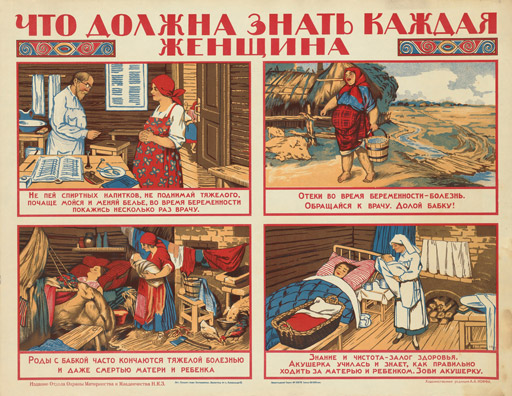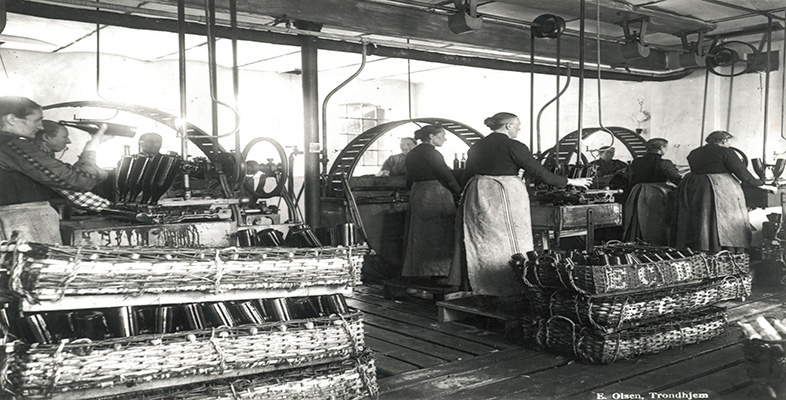Infant welfare
In the early twentieth century, children became a ‘national asset’ on whose health the future of nations depended. Every life was precious, and governments felt they had an urgent duty to tackle the problems of low birth rates and high infant mortality. However, states were hesitant to deal with birth rates, which required governments to intervene in the most intimate area of family life. Some governments – mostly those on the political right – tinkered with policies to increase family size. They discouraged the use of contraception and outlawed abortion. They imposed financial disincentives for those who failed to marry: single men and women in France and bachelors in Italy were required to pay extra income tax. Women who had large families were rewarded with medals and commendations. None of this had much impact on birth rates (Quine, 1996).
Governments and voluntary organisations were much more comfortable with policies aimed at saving the lives and improving the health of infants. There was remarkably wide support for such policies, from thinkers of all political persuasions. Imperialists were in favour of improving the health of children as a way of ensuring recruits to help maintain overseas interests. Socialist thinkers wanted the state to help poor families to bring up future citizens and to recognise the value of the women’s labour in rearing the next generation, while those on the right saw support for infants as a means of strengthening the family as a whole. Eugenicists, concerned with the future of races and peoples, advocated positive eugenic policies, encouraging healthy, hardworking parents to have children, and support to ensure that infants grew to be strong and healthy (Bock and Thane, 1991; Davin, 1978). In recent years, historians have pointed to the key role played by middle-class women in campaigning for, organising and staffing welfare schemes, one of the first arenas where women claimed a political voice. Women had traditionally provided charitable aid to the poor, and they readily took up the challenge of dealing with infant mortality, which was closely associated with urban poverty. What bound these often quite disparate groups of women was ‘maternalism’: a set of political ideas and actions that shifted motherhood and bringing up children from being a private responsibility to a matter of public policy (Koven and Michel, 1993).
There was also broad agreement on the target for welfare schemes – poor childrearing skills among mothers, rather than environmental conditions, such as poor housing or poverty (see Figure 4). In part, this was a matter of economics – wholesale improvements of poor housing stock in rapidly growing cities would be expensive – but it also reflected the strong ideology of motherhood found throughout Europe in the early twentieth century. It was seen as the duty and destiny of a woman to marry and to have children and her key domestic role was to rear children.

Infant welfare schemes were set up across Europe in the early decades of the century and the war simply gave an additional impetus to their work. In Britain, the number of welfare centres increased from 842 in 1914 to almost 1,300 by 1918. These programmes took different forms in different countries. In France, centres called ‘Consultations de Nourissons’ and ‘Gouttes de lait’ were set up from the 1890s to encourage mothers to breastfeed their children and to provide free milk to those who were unable to do so. Staff at the centres monitored the development of babies receiving milk, and provided free medical care and advice on childrearing. Some facilities also offered free meals to breastfeeding mothers. At the same time, local authorities offered mothers a wide range of support – free midwifery care at the birth, registered nurses to look after infants, and small payments to stay in bed after the delivery and to help support the child in its first year. By contrast, British infant welfare schemes focused on maternal education rather than material help. Infant welfare centres (some of which were called ‘Schools for Mothers’) offered classes in how to cook, sew baby clothes, bath and feed infants. Babies were regularly weighed and inspected to ensure that they were developing normally. However, if any medical problems were uncovered, staff could only advise mothers to take their infants to a local doctor, who would charge for any treatment provided (Dwork, 1987).
The different approaches to infant welfare on each side of the English Channel grew out of a set of particular social conditions. In France, fears of a declining population were much stronger than in Britain, so government and voluntary associations were prepared to make more radical interventions to help save infant lives, and to invest more in helping mothers. Welfare also reflected patterns of female employment. Far more married women went out to work in France, placing their infants in the care of other women, from whom they received supplementary feeding. British associations were, in general, reluctant to provide direct forms of help, which might lead to welfare ‘dependency’. In Britain, the majority of working women were young and single. They moved out of the workplace when they married and were supported by their husbands. As a result, British welfare schemes were much more concerned not to interfere with the father’s responsibility to support his family.
At the time, these schemes were applauded for reducing infant mortality. The number of infant deaths fell from 140 per thousand births in 1900 to just 63 in 1930. Writing in 1939, George Newman (former medical officer to the Ministry of Health) reported that, through education, mothers had become more ‘child conscious’ and aware of the need for good childrearing practices (quoted in Dwork, 1987, p. 216). Historians have been more critical of infant welfare schemes, arguing that advice given by middle-class staff to poor mothers on the need to feed babies on expensive milk substitutes or take them to the doctor was at best useless and at worst actually increased the anxiety of mothers and the strain on family budgets (Ross, 1993). However, letters from mothers suggested that they had a positive view of infant welfare schemes. Using letters written at the time, Deborah Dwork concluded:
It is clear that these women wanted education, help, advice, and proper nutrition. … A woman … wrote: ‘… my feeling is that if it were possible to get Maternity Centres or schools for expectant mothers, it would be a godsend to many a woman; and also to get some little help in nourishing the body, such as a small quantity of fresh milk.’ Lack of education was specifically mentioned over and over again. They wanted, they said, instruction with regard to sex, contraception, hygiene, and child-rearing. ‘I think ignorance has more to do with suffering than anything,’ one woman contended, and she recommended that physicians give lectures to maternity groups. Another claimed that ‘from the advice that mothers have been able to get at the “Baby Welcome” here, many babies’ lives have been saved’. There is a ‘great need for a place where a young mother could go and get advice and, if necessary, nourishment’, a third concluded.
